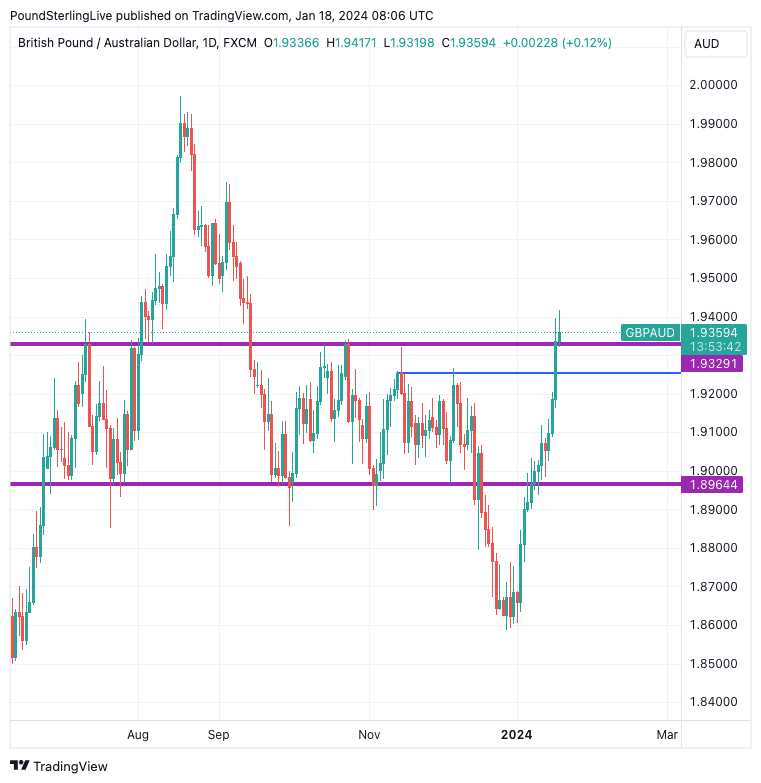Pound-Australian Dollar Hits 4-month High on Aus Labour Market Surprise
- Written by: Gary Howes
-

Image © Adobe Images
The Australian Dollar's status as the worst-performing major currency in the G10 arena was cemented Thursday following the release of below-consensus labour market data.
The Australian Dollar weakened after the ABS said Australia lost -65.1K jobs in December, disappointing a market that was expecting 17.6K jobs to be created.
Gains for the Pound to Australian Dollar exchange rate extended to a new multi-month high at 1.94 in the wake of the labour market data.
The high is at 1.9417, a level last seen on September 14.
The Australian to U.S. Dollar exchange rate dipped to 0.6525, before bouncing off this support level.
"AUD/USD temporarily dipped towards 0.6520 after the release of the Australian labour force survey," says Carol Kong, a strategist at Commonwealth Bank of Australia.
The ABS reported the number of people employed full-time declined by -106.6k; Westpac economists point out that this is the largest monthly fall on record outside of the COVID-19 period.
Above: GBP/AUD at daily intervals showing an attempted breach of the upper limit of a multi-month range is underway. Track GBP and USD with your custom rate alerts. Set Up Here.
The participation rate unexpectedly dipped to 66.8% in December, which was below the 67.1% the market was looking for. The unemployment rate stayed steady at 3.9%.
The ABS points to shifts in seasonal patterns as an important driver of recent results for employment, which should limit any major downside risks to the Aussie Dollar.
"The strength in employment in October and November and the fall in December, reflected changes in the timing of employment growth in the last few months of 2023, compared with earlier years," explained the ABS.
"This has likely meant that employers are hiring extra staff in October and November, instead of December," says Ryan Wells, an economist at Westpac.
Above: "Employment growth is gradually moderating" - Westpac.
"Looking through the monthly volatility though, employment growth has been tracking a monthly pace of 0.7% on a three-month rolling basis since September - lower than the pace of 0.9% recorded over the three months to June. This is consistent with a gradual slowing in employment growth and an unemployment rate that has begun to drift upwards into year-end," says Wells.
The Australian Dollar was one of the better-performing major currencies in the later stages of 2023 as investors saw the Reserve Bank of Australia as being one of the last to hike.
These labour statistics do, however, cast doubts on this assumption.
"Downside risks to growth cannot be ruled out," says Wells.
He explains that to date, the labour market has been a safety blanket for households experiencing intense cost of living pressures – the strong labour market has meant unemployed members of households could pick up a job, or employed members could pick up a second job or additional hours.
"Without this safety blanket, households may be forced to tighten their belts even further," says Wells.
More broadly, the Australian Dollar has come under pressure in 2024 as investors see the Federal Reserve cutting interest rates later and by less than previously anticipated.
This has weighed on global equity markets and commodities, which is particularly relevant to 'commodity currencies' such as AUD.
But the commodity complex is also under pressure owing to China's lacklustre growth: iron ore - Australia's prime export - has struggled since the start of the year as Chinese steel production disappoints.
Nevertheless, "we are constructive on the Australian Dollar over 2024," say analysts at Bank of America, hinting that the current woes could give way.
According to Bank of America, factors to expect AUD outperformance this year include:
- The RBA is to be among the few central banks that do not cut in 2024, partly because the policy rate is less restrictive than elsewhere.
- China sentiment remains at bearish extremes.
- Service sector exports have recovered sharply but not yet back to trend levels nor share of exports observed pre-pandemic – the recovery could further support AUD.
- Australia remains in a strong fiscal position relative to its G10 peers, both in terms of deficit and debt levels. This allows some room for fiscal support in the event of a growth downturn, reducing the burden on monetary easing.
- While AUD is perceived as a “high beta” currency, an improving NIIP should reduce its sensitivity to risk over time.


